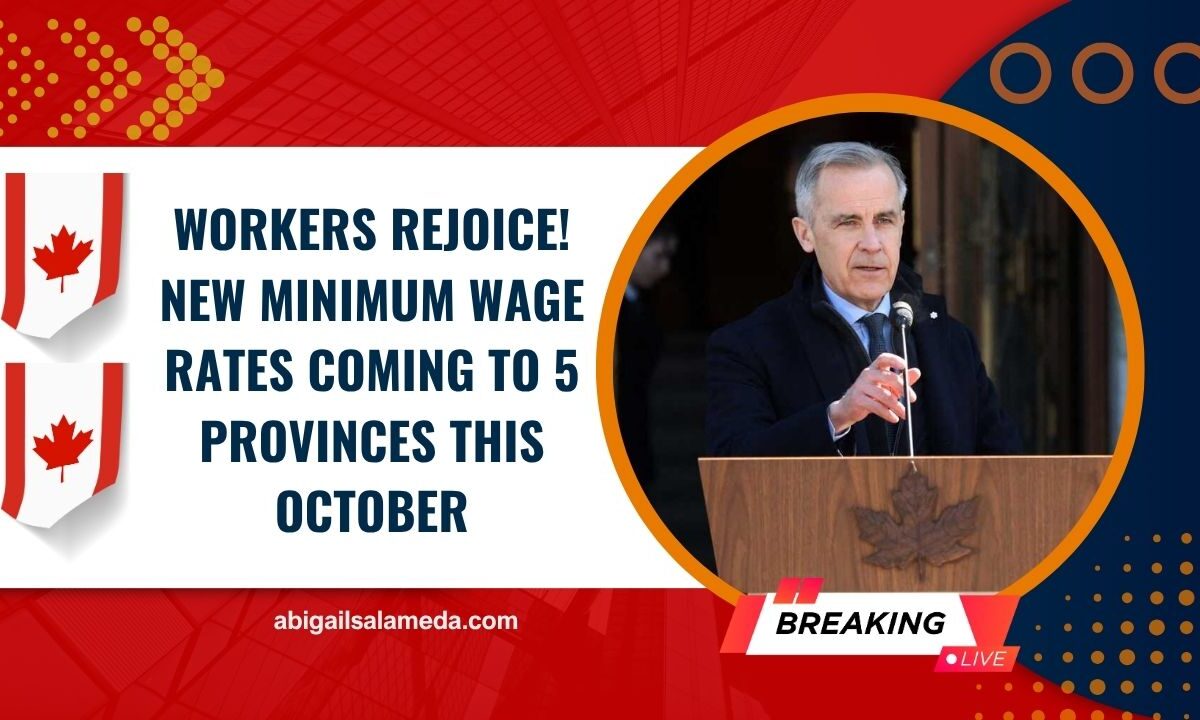Starting October 1, 2025, five Canadian provinces—Ontario, Manitoba, Saskatchewan, Nova Scotia, and Prince Edward Island—are set to increase their minimum wage rates. These updates reflect a growing effort to help workers keep up with inflation, support household expenses, and foster a more balanced economy.
Whether you’re a worker, student, employer, or policymaker, you must comprehend these changes and their implications for your province.
New Minimum Wages: Province-by-Province Breakdown
| Province | Current Wage | New Wage (Oct 1, 2025) | Special Notes |
|---|---|---|---|
| Ontario | $17.20 | $17.60 | Students: $16.60; Homeworkers: $19.35 |
| Manitoba | $15.80 | $16.00 | CPI-adjusted annually |
| Saskatchewan | $15.00 | $15.35 | Consistent, gradual increase approach |
| Nova Scotia | $15.70 | $16.50 | Two wage hikes in 2025; last was April 1 |
| Prince Edward Island | $16.00 | $16.50 | Future increase to $17.00 planned for April 1, 2026 |
Ontario: Supporting All Types of Workers
Ontario is increasing its general minimum wage to $17.60/hour, up from $17.20. The province is also adjusting special rates:
- Student wage: Rising from $16.20 to $16.60/hour (for those under 18 working part-time during school terms)
- Homeworker wage: Increasing from $18.90 to $19.35/hour
These pay hikes assure more equitable compensation across all job groups, particularly those who generally earn less than the standard rate.
Manitoba: Small Steps, Big Impact
Manitoba’s minimum wage will increase from $15.80 to $16.00 per hour. This modest move is part of a larger approach linking minimum wage changes to the province’s Consumer Price Index (CPI). This ensure that earnings reflect current cost-of-living conditions and inflation patterns.
This modification largely benefits employees in the retail, hotel, and other hourly pay sectors.
Saskatchewan: Gradual Yet Steady Progress
Saskatchewan’s minimum wage is set to increase from $15.00 to $15.35 per hour. Although modest compared to other provinces, this raise reflects the province’s ongoing commitment to steady wage growth while balancing the needs of workers and the sustainability of businesses.
This move supports entry-level workers across the province, particularly in agriculture and service industries.
Nova Scotia: Two Boosts in One Year
Nova Scotia raised its minimum wage once in 2025, from $15.20 to $15.70/hour in April. A second increase is coming October 1, when the rate will jump to $16.50/hour.
The province has consistently followed a policy of biannual reviews, aiming to keep wages aligned with inflation while providing predictable growth for businesses and workers alike.
Prince Edward Island: Looking Ahead
Prince Edward Island’s minimum wage will increase to $16.50/hour on October 1, up from $16.00. A second hike is already scheduled, pushing the wage to $17.00/hour by April 1, 2026.
These forward-planned increases offer both workers and employers transparency and time to prepare. PEI’s major employment sectors—like tourism, farming, and food services—stand to benefit most.
Minimum Wage Snapshot Across Canada – October 2025
To give you a national picture, here are the latest minimum wage rates across Canadian provinces and territories as of October 1, 2025:
| Region | Wage (Oct 1, 2025) | Next Planned Increase |
|---|---|---|
| Ontario | $17.60 | TBD |
| Manitoba | $16.00 | TBD |
| Saskatchewan | $15.35 | TBD |
| Nova Scotia | $16.50 | TBD |
| Prince Edward Island | $16.50 | $17.00 on April 1, 2026 |
| Alberta | $15.00 | Not announced |
| British Columbia | $17.85 | June 1, 2026 |
| Quebec | $16.10 | May 1, 2026 |
| Newfoundland & Labrador | $16.00 | April 1, 2026 |
| New Brunswick | $15.65 | April 1, 2026 |
| Yukon | $17.94 | April 1, 2026 |
| Northwest Territories | $16.70 | TBD |
| Nunavut | $19.00 | TBD |
| Federal (Regulated) | $17.75 | April 1, 2026 |
What This Means for Workers and Employers
For Workers:
- Increased earnings help offset rising expenses in rent, groceries, and transportation.
- Provides greater financial stability, especially for part-time, seasonal, and student workers.
- Encourages workforce participation and reduces turnover in low-wage jobs.
For Employers:
- May require payroll adjustments and cost forecasting.
- It could improve employee satisfaction and retention.
- Some businesses, especially small enterprises, may need support to adapt to rising labor costs.
The minimum wage increase will take effect from October 1, 2025, across Ontario, Manitoba, Saskatchewan, Nova Scotia, and Prince Edward Island signal a strong push toward fairer compensation.
These wage hikes are tailored to help workers cope with inflation while giving businesses a structured timeline for adaptation.
Whether you’re a worker expecting a pay raise or an employer preparing for compliance, staying ahead of these changes ensures you’re ready for Canada’s evolving economic landscape.
The momentum behind these increases indicate a national commitment to promoting income equality and financial security.
FAQs
Will all workers in these provinces automatically receive the new wage?
Yes. Employers must legally pay the new minimum wage to all eligible workers, effective October 1, 2025.
Are part-time and student workers included in these increases?
Yes, but student workers in Ontario have a separate rate —$16.60/hour—that is still subject to increase.
Can employers delay implementing the new rates?
No. Minimum wage laws are enforceable immediately on the effective date. Employers must comply or face penalties.





I would like to know Whu Minimum Wage isn’t going up from $15.00 Per Hour for all Albertans!!
And Minimum wages, is Extremely hard for People can’t make a Living on only this Minimal Wages.
Not so much for Me but other Team Members that I Work With !!!!!